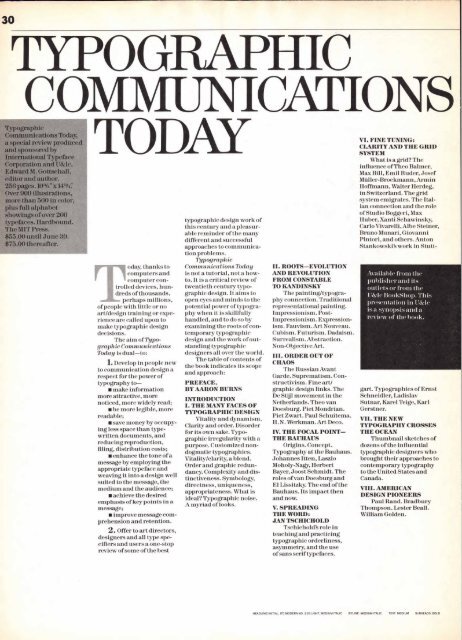Volume 16–1.pdf
Volume 16–1.pdf
Volume 16–1.pdf
You also want an ePaper? Increase the reach of your titles
YUMPU automatically turns print PDFs into web optimized ePapers that Google loves.
30<br />
TYPOGRAPHIC<br />
COMMUNICATIONS<br />
Typographic<br />
Communications TOday,<br />
a special review produce4<br />
and sponsored by<br />
International Typeface<br />
Corporation and USelc,<br />
Edward M. Gottschall,<br />
editor and author.<br />
256 pages. 103/4" x14 3/4 1:<br />
Over 900 illustrations,<br />
more than 500 in col<br />
plus full alphabet<br />
showings of over 20<br />
typefaces. Hardbound.<br />
The MIT Press.<br />
$55.00 until June 30.<br />
$75.00 thereafter.<br />
TODAY<br />
oday, thanks to<br />
typographic design work of<br />
this century and a pleasurable<br />
reminder of the many<br />
different and successful<br />
approaches to communication<br />
problems.<br />
Typographic<br />
Communications Today II. ROOTS—EVOLUTION<br />
computers and is not a tutorial, not a how- AND REVOLUTION<br />
computer con- to. It is a critical review of FROM CONSTABLE<br />
trolled devices, hun- twentieth century typo- TO KANDINSKY<br />
dreds of thousands, graphic design. It aims to The painting/typograperhaps<br />
millions, open eyes and minds to the phy connection. Traditional<br />
of people with little or no potential power of typogra- representational painting.<br />
art/design training or expe- phy when it is skillfully Impressionism. Postrience<br />
are called upon to handled, and to do so by Impressionism. Expressionmake<br />
typographic design examining the roots of con- ism. Fauvism. Art Nouveau.<br />
decisions. temporary typographic Cubism. Futurism. Dadaism.<br />
The aim of Typo- design and the work of out- Surrealism. Abstraction.<br />
graphic Communications standing typographic Non-Objective Art.<br />
Today is dual—to:<br />
1. Develop in people new<br />
designers all over the world.<br />
The table of contents of<br />
the book indicates its scope<br />
III. ORDER OUT OF<br />
CHAOS<br />
VI. FINE TUNING:<br />
CLARITY AND THE GRID<br />
SYSTEM<br />
What is a grid? The<br />
influence of Theo Balmer,<br />
Max Bill, Emil Ruder, Josef<br />
Muller-Brockmann, Armin<br />
Hoffmann, Walter Herdeg,<br />
in Switzerland. The grid<br />
system emigrates. The Italian<br />
connection and the role<br />
of Studio Boggeri, Max<br />
Huber, Xanti Schawinsky,<br />
Carlo Vivarelli, Albe Steiner,<br />
Bruno Munari, Giovanni<br />
Pintori, and others. Anton<br />
Stankowskii, work in Stutt-<br />
Available from the<br />
publisher and its<br />
outlets or from the<br />
BookShop. This<br />
presentation in [WIc<br />
is a synopsis and a<br />
review of the book.<br />
to communication design a<br />
respect for the power of<br />
and approach:<br />
The Russian Avant<br />
Garde. Suprematism. Con-<br />
typography to— PREFACE,<br />
structivism. Fine art/<br />
■make information BY AARON BURNS graphic design links. The gart. Typographies of Ernst<br />
more attractive, more<br />
noticed, more widely read;<br />
■be more legible, more<br />
readable;<br />
save money by occupying<br />
less space than typewritten<br />
documents, and<br />
reducing reproduction,<br />
filing, distribution costs;<br />
enhance the tone of a<br />
message by employing the<br />
appropriate typeface and<br />
weaving it into a design well<br />
suited to the message, the<br />
medium and the audience;<br />
is achieve the desired<br />
emphasis of key points in a<br />
message;<br />
■improve message com-<br />
INTRODUCTION<br />
I. THE MANY FACES OF<br />
TYPOGRAPHIC DESIGN<br />
Vitality and dynamism.<br />
Clarity and order. Disorder<br />
for its own sake. Typographic<br />
irregularity with a<br />
purpose. Customized nondogmatic<br />
typographies.<br />
Vitality/clarity, a blend.<br />
Order and graphic redundancy.<br />
Complexity and distinctiveness.<br />
Symbology,<br />
directness, uniqueness,<br />
appropriateness. What is<br />
ideal? Typographic noise.<br />
A myriad of looks.<br />
De Stijl movement in the Schneidler, Ladislav<br />
Netherlands. Theo van Sutnar, Karel Teige, Karl<br />
Doesburg. Piet Mondrian. Gerstner.<br />
Piet Zwart. Paul Schuitema.<br />
VII. THE NEW<br />
H. N. Werkman. Art Deco.<br />
TYPOGRAPHY CROSSES<br />
IV. THE FOCAL POINT— THE OCEAN<br />
THE BAUHAUS Thumbnail sketches of<br />
Origins. Concept. dozens of the influential<br />
Typography at the Bauhaus. typographic designers who<br />
Johannes Itten, Laszlo brought their approaches to<br />
Moholy-Nagy, Herbert contemporary typography<br />
Bayer, Joost Schmidt. The to the United States and<br />
roles of van Doesburg and Canada.<br />
El Lissitzky. The end of the<br />
VIII. AMERICAN<br />
Bauhaus. Its impact then<br />
DESIGN PIONEERS<br />
and now.<br />
Paul Rand. Bradbury<br />
V. SPREADING Thompson. Lester Beall.<br />
THE WORD: William Golden.<br />
prehension and retention.<br />
JAN TSCHICHOLD<br />
2. Offer to art directors,<br />
designers and all type specifiers<br />
and users a one-stop<br />
review of some of the best<br />
Tschichol& role in<br />
teaching and practicing<br />
typographic orderliness,<br />
asymmetry, and the use<br />
of sans serif typefaces.<br />
HEADLINE/INITIAL: ITC MODERN NO 216 LIGHT, MEDIUM ITALIC BYLINE: MEDIUM ITALIC TEXT: MEDIUM SUBHEADS. BOLD
















